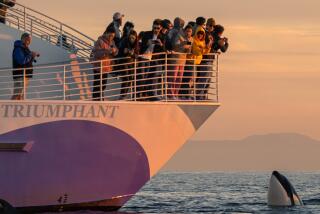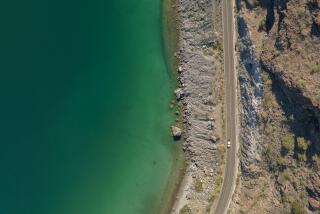Hooking up, but not for the long-term
- Share via
CABO SAN LUCAS, MEXICO — The sonar screen reveals a large yellow mass 100 feet beneath the surface.
The captain’s eyes widen as he idles the boat and turns to alert the deckhand.
A large school of mackerel, he explains, has gathered in defensive posture against predators, presumably marlin.
Hooks are baited and casts made, and soon three passengers are pressed against the rail, two to the starboard and one to port, holding their rod tips high and struggling mightily to turn the seemingly unstoppable billfish.
In the shimmering distance, they jump and gyrate, amid numerous other yachts, some with anglers also hooked up.
*
Welcome to the Golden Gate, an offshore seamount 21 miles north of Cabo San Lucas’ famous arch at the tip of the Baja California peninsula.
It’s one of only a few locations off Baja that lure striped marlin by the hundreds, if not thousands, and for about 12 weeks each year, it’s one of the world’s top marlin-fishing locations.
It is Jobe Villavicencio’s home away from home these days, but this is a captain who spends nearly 300 days a year at the helm of Ni Modo, a 42-foot yacht booked through Pisces Sportfishing.
Villavicencio, 28, has uncanny fish sense, but he’s a modest young salt, saying simply that “fishing is usually pretty good” at this time of year. His logbook, however, reveals that this has been a very good start to the season.
On this late November day, he will return to port flying seven marlin flags, signifying his count, plus a sailfish flag and two dorado flags.
That will conclude a week during which he and mate Hernando Gonzalez have logged 46 marlin releases for their clients, with a top daily count of 13.
That such catch rates can still be had might be at least partly thanks to a strong catch-and-release ethic prevalent among most local landing operators.
Or it could simply be the cyclical nature of billfish angling. During the previous few seasons, mackerel weren’t as abundant and fishing was subpar, by Golden Gate standards.
Like many species, marlin face increasing challenges, such as climactic changes and, in these very waters, pressure from commercial fishermen, who are not permitted to target billfish but catch them anyway with indiscriminate long-line gear.
Even so, this is shaping up as a throwback season and the bite should last into early February. After that, as the mackerel disperse, many of the marlin will slowly migrate around the peninsula into the Sea of Cortez.
When that happens, they’ll become even more accessible to Cabo San Lucas anglers, though not in such a high concentration.
There are exceptions: During a release tournament in May, a team led by Anthony Hsieh, a renowned Newport Beach angler who owns the luxury sport-fisher Bad Company, tallied 30 marlin in three days not far from Land’s End.
Anglers on that vessel caught six marlin on a recent day trip.
“It’s really nice to see that the bait has returned like it has,” Hsieh says.
*
On Ni Modo, anglers generally use 40- or 50-pound-test line and state-of-the-art Penn International reels, unless they bring their own equipment.
Marlin should be released as quickly as possible, so Villavicencio is constantly maneuvering the boat during the fight -- not easy when there are multiple hookups. Still, the fights typically last 30 minutes or longer.
At the Golden Gate, multiple hookups are common and usually chaotic.
“We’ve had four on at a time, many times,” Villavicencio says.
Five minutes after the triple hookup, on a shifting, wind-swept ocean, one marlin shakes free, causing Gonzalez, who is standing by, a mild spasm.
Twenty minutes later, Mark Matson brings to leader his first sailfish. Fifteen minutes after that, Matt Miller has brought to leader his second marlin of the day, and tries to shake feeling back into his trembling left arm.
“The fight is incredible, you know, but it’s almost too long,” says the 31-year-old fly-fishing guide from Missoula, Mont. “You almost just want to move on to the next one because that’s not the exciting part -- to sit there and battle them for an hour. It’s the initial process -- watching them eat it, or at least pretend to eat it.”
Matson, 50, a building inspector for Santa Barbara County, had earlier caught his first dorado and would soon notch his first marlin.
His previous big fish had been a 12-pound halibut and various rockfish caught off Central California.
“You can’t even compare this to catching rockfish,” he says. “This is like moving furniture. You can’t have your way with a 140-pound marlin. You have to wear it out and you do what it wants to do.”
Just who wore out whom is debatable, judging from the long, quiet ride to port.
More to Read
Sign up for The Wild
We’ll help you find the best places to hike, bike and run, as well as the perfect silent spots for meditation and yoga.
You may occasionally receive promotional content from the Los Angeles Times.






